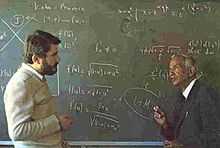Basilis C. Xanthopoulos

Basilis C. Xanthopoulos (also Vasilis; Greek: Βασίλης Κ. Ξανθόπουλος; 1951 – November 27, 1990) was a Greek theoretical physicist, well known in the field of general relativity for his contributions to the study of colliding plane waves.
Basilis Xanthopoulos was born in Drama, in 1951. After majoring in mathematics at the University of Thessaloniki he moved to the University of Chicago, where he earned his Ph.D. in 1978. During this time, he collaborated with Subrahmanyan Chandrasekhar on colliding plane waves. In particular, they discovered an exact solution which models two gravitational plane waves which collide, interact nonlinearly, and create in the interaction zone a curved region of spacetime which is locally isometric to the Kerr vacuum. This is now called the 'Chandrasekhar–Xanthopoulos colliding plane wave model.'
Xanthopoulos and his colleague Stephanos Pnevmatikos[1] were murdered by a 32-year old disgruntled post-graduate student, named Giorgos Petrodaskalakis (who later committed suicide),[2] on the evening of November 27, 1990 at the University of Crete.[3]
See also
- V. Xanthopoulos – S. Pnevmatikos: Award for Excellence in Academic Teaching[4] (awarded by the Foundation for Research and Technology - Hellas (FORTH)
Notes
- ↑ Biography of physicist S. Pnevmatikos and comments by physicist G.Grammatikakis (greek)
- ↑ Biography of V. Xanthopoulos and comments by physicist S.Traxanas (greek)
- ↑ Short biography of physicist S. Pnevmatikos, Mathematics Department - University of Patras (greek)
- ↑ Homepage of mathematician S.N. Pnevmatikos, Mathematics Department - University of Patras (greek)
References
- Page containing information about Xanthopoulos' life and death, and a short publication list of his works.
- Chandrasekhar, S. and Xanthopoulos, B. C. (October 1987). "On colliding waves that develop time-like singularities: a new class of solutions of the Einstein–Maxwell equations". Proc. Roy. Soc. A 410 (1839): 311–336. Bibcode:1987RSPSA.410..311C. doi:10.1098/rspa.1987.0041.; this paper gives the Chandrasekhar/Xanthopoulos colliding plane wave solution.